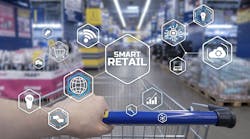Reimagining the End-to-End Retail Experience with IoT Technology
What you’ll learn:
How IoT-based solutions can enable the end-to-end retail experience.
The benefit of long-range, low-power technology to support the IoT.
By 2025, Statista predicts that there will be more than 75 billion Internet of Things (IoT) connected devices in use, and those devices will be deployed across a diverse set of industries, including retail. While businesses of all kinds are digitally transforming at what seems like warp speed, the retail industry is developing at a critical time where speed is essential to meet consumer demand.
Retailers aren’t only looking for data, but for actionable insights that result in greater efficiency, security, and a seamless experience for shoppers in-store and online throughout the entire purchase journey. Across integrated supply chains and front- and back-of-store operations, the retail experience continues to be bolstered by emerging technologies to enhance the employee, shopper, and ultimately enterprise experience for all.
Many technologies support the greater retail infrastructure today. However, the combination of intelligent hardware and software systems connected via an IoT network is one way to improve the two key areas that retail giants continue to invest in, namely operational readiness and the shopping experience.
This sophisticated suite of solutions work hand in hand to give retailers the opportunity to monitor and manage operations from product availability, convenience, and consumer insights through a single platform and deliver actionable data in real-time. If anything has proven to be critical over the past year and half, it’s real-time, actionable data to enable deep insights into enterprise operations. This allows retail managers visibility into their business at any time of day, plus it gives them more flexibility and encourages agility to be able to switch gears on a moment’s notice should something shift not according to plan.
Creating a Heightened In-Store Experience
While the COVID-19 pandemic caused major disruptions for retailers with a shift to e-commerce, brick-and-mortar storefronts are making a comeback during the vaccine rollout. In fact, a recent IBM consumer study found that at least one in five respondents expect to buy items in-store much more often, especially those shopping for toys, games, and hobbies; apparel; footwear; and accessories. To better manage this reentry into physical retail applications, businesses are prioritizing digital connectivity to the consumer and delivering more personalized shopping experiences.
One way that retailers can offer in-store, personalized interactivity with consumers is through wireless digital display solutions for phones, tablets, and electronic accessories. With clean, vertical presentation, consumers are enticed to interact with merchandise.
In sync with wireless sensors and IoT connectivity, associates can move freely around the storefront and sell complementary products to the consumer based on their discussions with the shopper. From a consumer experience, this extended freedom to interact with merchandise matched with employee expertise is the key to make the return to in-person shopping a success.
Not only do wireless digital solutions enhance the consumer experience, giving them the freedom to move about the store and really get an opportunity to handle a device, but store managers can be part of the stress-free experience. That’s because they know configurable parameters are put in place to also track potential theft, customer engagement, and additional product-related information across single, regional, or national store locations.
From zone mapping to help store managers understand how shoppers interact with a store’s product, to track and trace solutions to help manage inventory, and on-shelf sensors ensuring empty shelves don’t cost retailers missed sales opportunities, the combination of IoT technology and smart hardware/software platforms give retailers the data needed to reduce operational costs and gain valuable insights into consumer preferences.
As proven time and time again, experiential marketing tactics—allowing consumers to immerse themselves into your products and overall brand—are critical to the end-results every business needs: sales and brand loyalty.
Offering Reliable Data from the First to Last Mile
Retail storefronts often can be hit or miss depending on the in-store consumer experience. Still, everything that goes into that experience can’t be made possible without actual product availability in store. Long-range, low-power IoT-connected solutions makes it easy and affordable for smart supply chain and logistics to track highly valued assets that are in transit to brick-and-mortar stores. That combined with geolocation means assets can be easily monitored over large geographic regions even within harsh environments.
With connected asset tracking solutions, retailers will know when new product is arriving at all times, which enables thoughtful planning of storefront and merchandising design. Having real-time visibility into your supplier’s activity accelerates time-to-market, reduces operational design complexity, and decreases costs of over purchasing since retailers are aware of when their shipments are coming in. Such processes work both ways as product enters the store, but also as logistics and reverse logistics become more complex with the ramp up of in-store and online purchases and returns—especially ahead of the holiday season.
Retailers have big reputations to uphold and brands to build, and all of that can’t be done without a consumer’s trust. With IoT-connected solutions, retailers can offer consumers top performing in-store experiences. In parallel, they can provide internal benefits around asset tracking and upselling based on employee and consumer productivity throughout the storefront. With real-time data visibility offering actionable insights into retail operations, retailers can be confident with their in-store performance with the help of technology.
